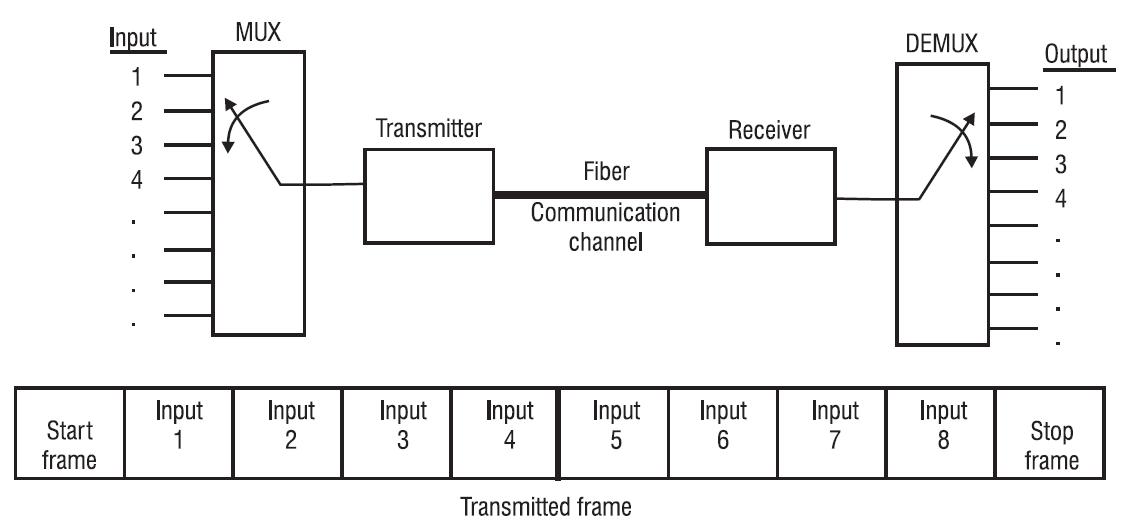Basicprinciple
Schematicdiagramofn-channeltime-divisionmultiplexingsystem:
Schematicdiagramofn-channeltime-divisionmultiplexingsystem(1picture)
Timedivisionmultiplexingissuitableforthetransmissionofdigitalsignals.Becausethebittransmissionrateofthechannelexceedsthedatatransmissionrateofeachsignal,thechannelcanbedividedintoseveralsegmentsaccordingtotimeandusedformultiplesignalsinturn.Eachtimesliceisseparatelyoccupiedbyamultiplexedsignal.Inaspecifiedtime,multipledigitalsignalscanbetransmittedandarrivedasrequired,whichalsorealizesthetransmissionofmultipledigitalsignalsonaphysicalchannel.Assumingthatthebitrateofeachinputdatais9.6kbit/sandthemaximumbitrateofthelineis76.8kbit/s,8signalscanbetransmitted.Atthereceivingend,asophisticateddecodercanaccuratelydistinguishdifferentdigitalsignalsbyreceivingsomeadditionalinformation.
Features
Timedivisionmultiplexingisbasedonthesamplingtheorem.Thesamplingtheoremmakesitpossibleforcontinuous(analog)basebandsignalstobereplacedbysamplingpulsevaluesthatappeardiscretelyintime.Inthisway,whenthesamplingpulseoccupiesashorttime,atimegapisleftbetweenthesamplingpulses,andthesamplingvalueofothersignalscanbetransmittedbyusingthisgap.Therefore,itispossibletotransmitseveralbasebandsignalssimultaneouslyalongachannel.
Timedivisionmultiplexingtechnology
Time-pisionmultiplexingtechnology(time-pisionmultiplexing,TDM)istointerweavedifferentsignalsindifferenttimeperiodsandtransmitthemalongthesamechannel;Atthereceivingend,useacertainmethodtoextractthesignalineachtimeperiodandrestoreittothecommunicationtechnologyoftheoriginalsignal.Thistechnologycantransmitmultiplesignalsonthesamechannel.
Applicationextension
TheTDMmethodisdividedintothefollowingtwotypes

Synchronoustimedivisionmultiplexingsystem(twotypes):
1,PlesiochronousseriesPDH(usedinpublictelephonenetworkPSTN).
2.SynchronousSDHseries(usedinbackbonenetworkssuchasopticalfibercommunication)
Statistics(asynchronous)timedivisionmultiplexingsystem(twotypes):
1,Virtualcircuitmode(suchasX.25,framerelay,ATM).
2.Datagrammethod(suchasTCP/IP)
PSTNsystemadoptsacombinationofPDHandSDH,andPCM/PDHisusedforaccessandexchangeofsmallusers,andthecorebackbonenetworkUseSDH.
TherearetwotypesofPDHstandardsintheworld
1.A30/32-channelPCMsystembasedonA-lawcompression(Europeanstandards,usedinEurope,China,Russia,etc.)
p>2,24-channelPCMsystembasedonu-lawcompression(Americanstandard,usedinNorthAmerica,Japan,Taiwan,etc.)
Timeslicedivision:
Synchronous)TimedivisionmultiplexingTDM,itstimesliceispre-allocated,anditisfixed,sothetransmissiontimingofvarioussignalsourcesissynchronized.Incontrast,asynchronoustimedivisionmultiplexing1DMallowsforthedynamicallocationoftimeslicesofthetransmissionmedium.
Development:
Althoughthetraditionalcircuittime-divisionmultiplexingtechnologyhasmatured,itisdifficulttofurtherincreasethetransmissionrateofasingleopticalfiberduetotheinfluenceoftheelectronicbottleneck.Thetransmissionrateofasingleopticalfibercanbe10Gbit/sbyusingelectricaltimedivisionmultiplexing.AlthoughtheGermanSHF40Gbit/selectricaltimedivisionmultiplexerhasbeencommercialized,itisveryexpensiveduetoitscomplextechnology.Therefore,inordertofurtherimprovethecommunicationcapacityoftheopticalcommunicationsystem,peoplefocusontheresearchfocusonthetwomultiplexingmodesofopticalwavelengthdivisionmultiplexing(WDM)andopticaltimedivisionmultiplexing(OTDM).
WDMistomultiplexmultipleopticalsignalsofdifferentwavelengthsonanopticalfiber,anddemultiplexthedifferentwavelengthsatthereceivingend.Duetothedevelopmentofgain-flatteningEDFA,whichhaspromotedthedevelopmentofWDMtechnology,WDMhasbecomeincreasinglymature.OTDMonlytransmitsopticalsignalsofonewavelengthonanopticalfiber.ItfirstrequiresthattheopticalpulsesmustbeRZcodes.Eachopticalsignalismultiplexedintoonechannelbyoccupyingdifferenttimeslots.Thefirstopticalpulsewithdifferenttimedelaysisusedtoincreasethetransmissionrateofasingleopticalfiber.WDMandOTDMeachhavetheirownadvantages,soitcanbeforeseenthatthecombinationofWDMandOTDMwillgreatlyincreasethecapacityofopticalcommunicationsandbecomeatrendinthedevelopmentofopticalcommunicationsinthefuture.
